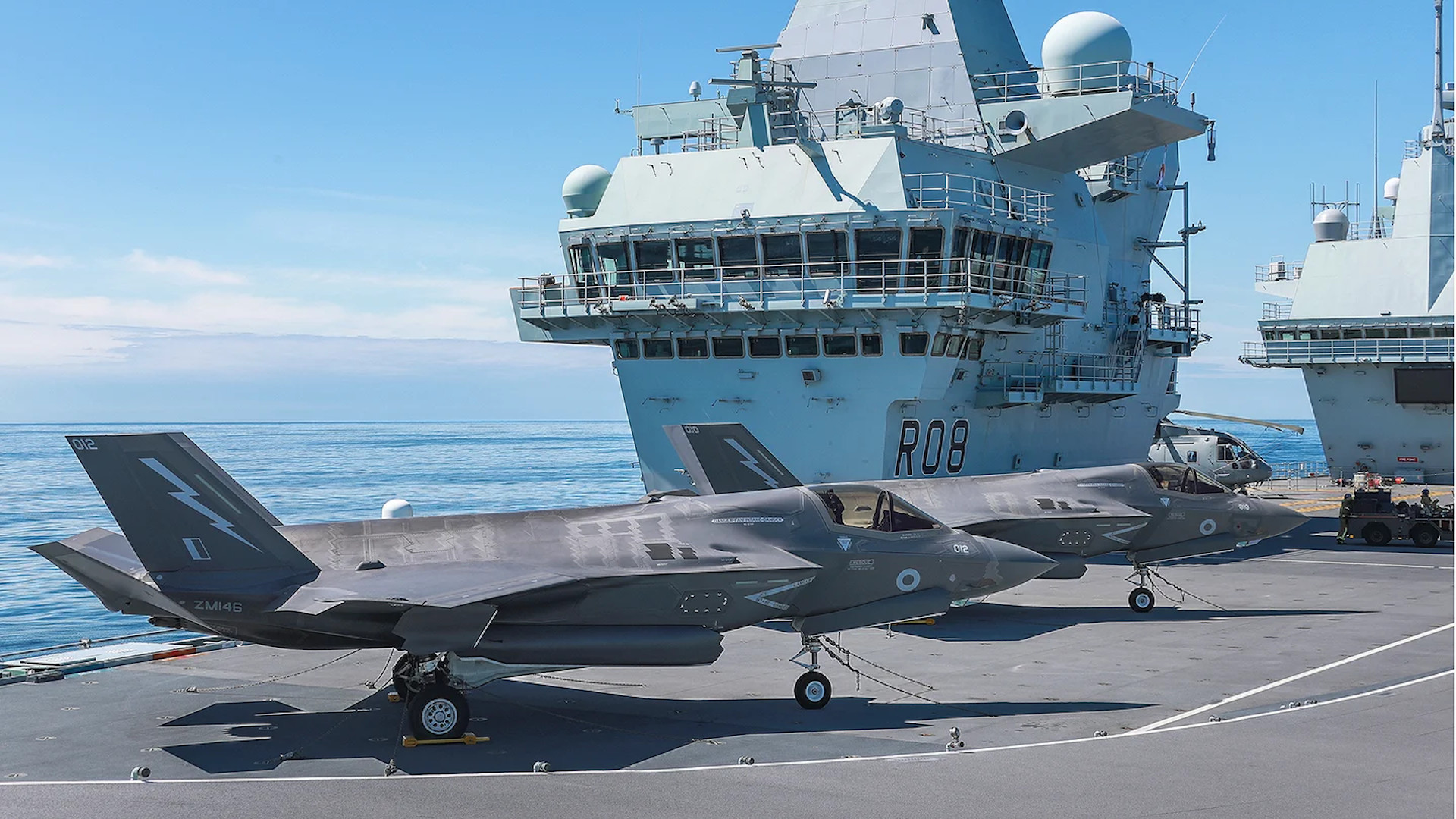The U.K. Ministry of Defense has confirmed that an F-35B Lightning stealth jet that was operating from the Royal Navy’s flagship, the aircraft carrier HMS Queen Elizabeth, currently underway in the eastern Mediterranean, crashed into the sea earlier today, soon after takeoff. Details are still limited, but the British pilot was able to eject safely and has been returned to the ship. The aircraft carrier is on its maiden operational cruise, and this is the first loss of a Joint Strike Fighter while operating from the deck of an aircraft carrier or amphibious assault ship.
The F-35B crashed during routine flying operations at approximately 10:00 AM U.K. time this morning, and no other aircraft were involved in the mishap. The U.K. Ministry of Defence has offered no additional details about the circumstances of the incident but has said that an investigation is now underway.

HMS Queen Elizabeth is back in the Mediterranean, having just recently transited north through the Suez Canal after having sailed to the Asia Pacific region as part of Carrier Strike Group 21, or CSG21, earlier this year, during a 26,000-nautical-mile cruise that planned to take in visits to 40 nations, as well as various bilateral and multinational exercises.
The preparations within the British Lightning Force, ahead of this major undertaking, are something that The War Zone
discussed in detail with Group Captain Jim Beck, the Station Commander of RAF Marham, the home base of the U.K. F-35Bs.
Prior to this mishap, the carrier had a contingent of eight F-35Bs from the Royal Air Force’s No. 617 Squadron, the “Dambusters,” onboard. These are embarked alongside 10 similar jets from the U.S. Marines Corps’ Marine Fighter Attack Squadron (VMFA) 211, the “Wake Island Avengers,” based at Marine Corps Air Station Yuma in Arizona, but currently under British command.
As well as HMS Queen Elizabeth, the Royal Navy elements of CSG21 consist of the Type 45 destroyers HMS Diamond and Defender, the Type 23 class frigates HMS Kent and Richmond, the replenishment tanker RFA Tidespring, the fleet tanker RFA Fort Victoria, and an undisclosed Royal Navy Astute class nuclear-powered attack submarine. They are also accompanied by U.S. Navy’s Arleigh Burke class destroyer USS The Sullivans, and the Dutch De Zeven Provinciën class frigate HNLMS Evertsen.
CSG21 had taken HMS Queen Elizabeth to the Mediterranean earlier this year as well, during which British F-35Bs launched their first combat missions, as part of the international coalition fighting ISIS in the Middle East. This was the first time that a Royal Navy warship embarking fixed-wing aircraft had taken part in combat operations since HMS Illustrious took part in the U.K. response to the crisis in Sierra Leone in 2000.

The loss of any jet fighter is a significant blow, but in the case of the United Kingdom, in particular, F-35B fleet numbers and costs have long been a point of fierce debate. To date, the United Kingdom has committed to buying 48 Lightnings by the end of 2025, at a cost of £10.5 billion. As of this morning, 24 of the jets had been delivered to the RAF, the three most recent examples arriving at RAF Marham in England in October.
Beyond that number, there has been a long-standing official target of 138 aircraft purchased across the lifespan of the program. However, the government has more recently admitted that the figure of 138 was taken “following some hesitation,” and most observers expect the number to be reduced, perhaps significantly.
The U.K. government’s Integrated Review Command Paper, published earlier this year, did commit to increasing the F-35B fleet size beyond the 48 already ordered but didn’t provide any more details on numbers, and there is a tacit acknowledgment that the planned 138-aircraft figure has been abandoned.
Overall, this is the fifth crash of an F-35, of all versions. The crash totals prior to this latest incident were two U.S. Marine Corps F-35Bs, which we reported on here and here, one U.S. Air Force F-35A, and one Japan Air Self-Defense Force F-35A. This tally does not include ground incidents, including engine fires and undercarriage failures on landing, for example.
Update, 5:00 PM GMT: We now have apparent confirmation that the F-35B lost earlier today was indeed one of the eight embarked British jets, assigned to the Royal Air Force’s No. 617 Squadron and was not a U.S. Marine Corps jet flown by a British pilot.
Paul D. Shinkman, the National Security Correspondent for US News, tweeted that the U.K. Foreign, Commonwealth & Development Office confirmed that the “pilot is British [and] was flying a British plane.”
Update, 8:00 PM GMT: The Headquarters Marine Corps has also now confirmed that it was not a USMC jet that was lost and provided us with the following statement:
“We are pleased to hear that the British pilot is safe and back aboard HMS Queen Elizabeth after ejecting from a U.K. F-35 over the Mediterranean. U.S. participation in the U.K.’s Carrier Strike Group 21 has allowed us to train with the U.K., improve readiness and interoperability, and respond to situations such as these.”
Meanwhile, the @DefenceSenseUK notes that the mishap pilot was recovered by an embarked Merlin helicopter from the aircraft carrier.
Among its rotary-wing component, HMS Queen Elizabeth currently embarks Commando Merlin helicopters from 845 Naval Air Squadron, as well as anti-submarine warfare and airborne early warning Merlin HM2s from 820 Naval Air Squadron.
Contact the author: thomas@thedrive.com
